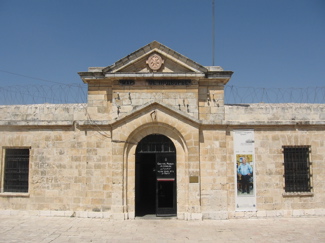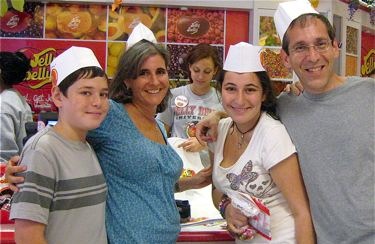 Just when you think you’ve seen all that Jerusalem has to offer, along comes a surprise in the most unusual of spaces.
Just when you think you’ve seen all that Jerusalem has to offer, along comes a surprise in the most unusual of spaces.
For weeks, the Jerusalem municipality has been running full-page ads promoting Art Jerusalem 08, an exhibition with hundreds of mostly new and unknown artists. The setting was the Underground Prisoner’s Museum just off Kikar Safra (City Hall Plaza) in the Russian Compound neighborhood.
The fair was fabulous, ranging from under appreciated impressionists like Reuven Rubin to up and coming artists such as Ra’anana-based Estee Kreisman whose paint-on-photo panoramic canvases were one of our favorites. There was also a fair sprinkling of multimedia new age video and music-centric installations.
Art was also for sale. In one gallery, you could pick up a pint-sized version of David Gerstein’s striking multi-layered metal-on-metal sculptures or gaze longingly at an authentic Agam. There was an exhibition of just Bob Dylan photographs and even a Sotheby’s gallery featuring paintings for sale (at prices jumping to the hundreds of thousands of dollars for some works).
The highlight, though, was not the art itself but the interplay between the exhibition and the museum. The Underground Prisoner’s Museum was new to us (though both of our older kids have taken school field trips there). The museum is set in and around a former British jail used to house inmates ranging from petty criminals to political prisoners from 1918 to 1948 when the British quit Palestine. The building itself dates back to 1858 when it was served as a Russian pilgrims’ hospice for women.
The exhibits depict life in the prison and tell the stories of the underground groups and their members in order to perpetuate their memories. Incarceration resulted from offenses that included putting up posters, training and possession of weapons, and physical assault. At its height, the prison population totaled 250.
There are several long corridors lined with prison cells where inmates slept 8 to a room on thin woven mattresses on the floor. We toured the solitary confinement cells, the infirmary, synagogue and death row. Prisoners from the Jewish underground were put to work making coffins and gravestones for British policemen and soldiers they had killed in combat.
In retaliation, the British executed tens of Jews from the Irgun, Hagana and Lechi brigades during the time the jail was in operation (most of the underground members were transferred to the prison in Acre for execution). Large photographs of each of the underground fighters executed are displayed in an emotionally wrenching gallery.
Special mention is made of Meir Feinstein and Moshe Barzani who were sentenced to death in 1946. Rather than face death at the hands of the British, they smuggled in two grenades (hidden in orange peels and placed in a fruit basket) and blew themselves up at the foot of the gallows.
Yes, the sentence of death was by hanging. The gallows is still displayed in the museum, but the room has now been transformed into a testament to the fighters who gave their lives to help establish the state of Israel: a large illuminated plaque with the words to HaTikva, the Israeli national anthem, appears just behind the hanging noose.
For the art fair, the museum was sprinkled with sculpture and paintings throughout. In the locked solitary confinement cells, for example, modern art works appeared, bracketed by the metal cell doors. Golden etrogs (the citron fruit used during the Jewish holiday of Sukkot)were stationed near the bakery. A set of calligraphy prints, highlighting Jewish and religious themes, were hung in the room where 12 inmates surreptitiously dug a tunnel before making a daring – and successful – escape.
The building served various purposes in the 40+ years after it ceased operating as a prison, including as a storehouse for archives from the Jewish Agency. It was transferred to the Ministry of Defense in 1991, which restored the prison and turned it into a museum.
Even without the art fair (which closed October 21), it’s well worth a visit for Jerusalemites who’ve never been and for visitors for which it is off the well-worn tourist track.
To get to the Underground Prisoner’s Museum, park in the Kikar Safra parking lot and take the elevator up to the plaza. On the east side of the plaza there’s a walkway into the Russian Compound. The museum is on your immediate right. Number 1, Mishol Hagevura. +972-2-623-3166. Guided tours in English are available for groups if booked in advance.
A video walkthrough is available on YouTube.
http://www.youtube.com/watch?v=V6ZBeRY7664
<div><a href=”xx” mce_href=”xx”><img loading=”lazy” decoding=”async” src=”/_images/print.gif” mce_src=”/_images/print.gif” border=”0″ width=”20″ height=”20″ alt=”Print this article”></a> <a href=”xx” mce_href=”xx”>Print Article</a></div>

